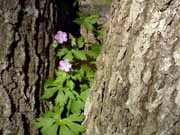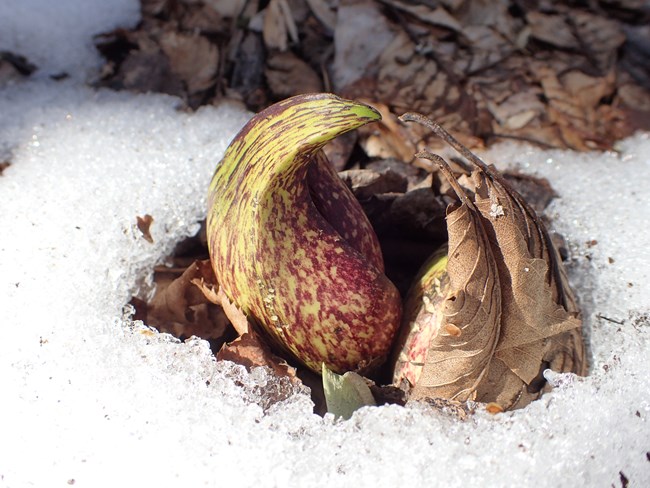
Volunteer John Zuke 
(photo by James Voigt) Wildflowers that may be seen include spring beauties, cutleaf toothwort, wild geranium, bloodroot, wild ginger, rue anemone, wood anemone, yellow violet, yellow trout lily, cardinal flower, hepatica, jack-in-the-pulpit, several species of orchid, mayapples, and more.
Several Maryland listed endangered, threatened, and "watch list" plant species reside in the park. One exceptionally beautiful species, the purple-fringed orchid is listed as threatened by the state. The purple-fringed orchid is rarely seen in the park and it appears that their population is declining, perhaps due to over browsing by deer and lack of suitable habitat. Special measures have been taken to prevent the loss of this unique orchid. Wire cages are placed around individual plants to protect them from deer. The Resource Management staff at Catoctin also performs yearly surveys to monitor these rare, beautiful orchids and preserve their existence. Unfortunately other orchids haven't been as successful, such as the lady slipper orchid that was commonly found at Catoctin, but has since disappeared. Some excellent places to look for wildflowers include Brown's Farm Trail, roadside pull-offs along Big Hunting Creek, and the Blue Blazes Still Trail. Wildflowers can also be seen alongside most trails in the park. Please do not pick the wildflowers! Picking wildflowers not only denies others the opportunity to admire their beauty, but it also threatens the existence of the plant, and is illegal in all National Park units. It is also illegal to collect seeds from wildflowers. Catoctin Mountain Park offers guided "Wildflower Walks" in April and May. Check with the Visitor Center for exact dates and location. 
NPS Photo/Becky Loncosky Skunk cabbage (Symplocarpus foetidus) is a low-growing wetland plant in the arum family. Members of the arum family also include jack-in-the-pulpit and popular potted plants like peace lily and pothos. Plants in the arum family have flowers that consist of a leaf-like spathe surrounding a spike or knob-like spadix, unlike the usual corolla surrounded by petals associated with a “normal” flower. The flower of skunk cabbage creates heat that can melt the snow through which it emerges. It can sometimes be 35 degrees Fahrenheit warmer that the surrounding air. This heat also helps to dissipate a rotten smell that draws flies and beetles that pollinate the plant. The plant creates this heat by breaking down starch found it its roots, much the way a mammal burns calories to stay warm. Later in the year the skunk cabbage has large green leaves that grow directly out of the ground that resemble a cabbage plant. There are often many plants growing together. Skunk cabbage are obligate wetland plants, meaning that they only grow were it stays wet for most of the year. It gets its name from the pungent smell of its leaves when they are crushed or torn. The species name, foetidus, shares its root with the word “fetid,” which means "stinking." The leaves appear in spring after the spathe is fading. |
Last updated: March 16, 2021
